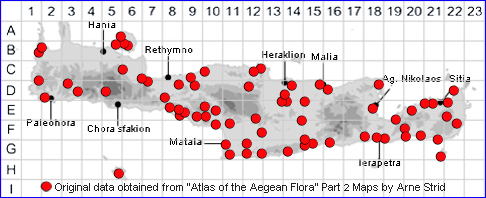
SPECIES DESCRIPTION
OPHRYS TENTHREDINIFERA
A distinct and easily identifed species. Individual variation in size, colour and
flowering time has led to the description of several species and subspecies that are
scarcely worthy of taxonomic recognition at any level. 1) I have Included the
following two species which are known to occur on Crete
subsp. leochroma and subsp. villosa. See links below for more information
1) "Atlas of the Aegean Flora" Book1, Arne Strid 2016.
Family:- ORCHIDACEAE
Common Names:- Sawfly orchid
Synonyms:- None
Meaning:- Ophrys (L) Eye-brow, a name used by the Roman naturalist and
philosopher Pliny.
Tenthredinifera (L) Insect-bearing, harbouring sawflies.
General description:- Short to medium perennial, to 45 cm tall.
Leaves:-
1) Basal, oval to lance-shaped, blunt or pointed.
2) Stem, similar though generally narrower.
Flowers:-
1) Spike 3- to 8-flowered, lax.
2) Perianth-segments:
a) purplish or purplish-violet, rarely whitish.
b) outer 6-12 mm, broadly ovate, obtuse, hairless (glabrous), concave.
c) inner usually 1/3 as long as the outer, broadly triangular, covered with small
nipple-like projections or with very short dense velvety hairs (papillose-
velutinous).
3) Labellum:
a) (8-)11-14 x 11-14 mm.
b) obovate, square or fan-shaped (flabelliform), convex, entire, rarely oblong and
distinctly notched at the apex (emarginate) or indistinctly 3-lobed.
c) purplish-brown, velutinous, usually with a wide, yellow, densely hairy marginal
zone, with a glabrous appendage, with short, inconspicuous basal
protuberances.
d) speculum reduced, often 2-fid, rarely round and slightly bulging (scutelliform),
composed of brown spots.
4) Connective obtuse.
Fruit:-
Key features:-
1) Labellum entire to deeply 3-lobed, the lateral lobes not gibbous or deflexed.
2) Outer perianth-segments purplish.
Habitat:- Dry open shrubby vegetation, open woodland, fallow fields, old olive
groves. 0-500(-1200) m.
Distribution:- Iberian Peninsula and N Africa eastwards to Turkey - not Cyprus.
Widespread and common on Crete.
Flowering time:- Feb to early May.
Photos by:- Steve Lenton & Fotis Samaritakis subsp. leochroma
FAMILY AND GENUS DESCRIPTIONS
ORCHIDACEAE
General description:- Perennial herbs with rhizomes, vertical stock or tuberous
roots, terrestrial, sometimes obtaining nutrition from decaying matter (saprophytic),
usually with symbiotic fungi in or on the roots (mycorrhiza).
Stems:- Sometimes swollen at base to form pseudobulbs.
Leaves:- Entire, spirally arranged or in two opposite rows, one on each side of the
stem (distichous), rarely subopposite, reduced to scales or sheaths in
saprophytes.
Flowers:- Inflorescence a spike or raceme. Flowers zygomorphic, the sepals,
petals and stamens apparently inserted higher than the ovary (epigynous), usually
hermaphrodite. Perianth-segments 6, in 2 whorls; median inner segment (labellum)
usually larger and of different shape from the others, usually directed downwards
owing to the ovary or the stem (pedicel) twisting through 180°, often with basal
spur. Anthers and stigma borne on a column formed from fused filaments and style;
stamens 1, rarely 2, with stalkless (sessile) or short-stalked (subsessile), 2-celled
(2-locular) anthers behind or at the summit of the column; pollen-grains single or in
tetrads, bound by elastic threads in packets (pollinia) which may be narrowed into a
sterile, stalk-like caudicle. Ovary inferior, 1-locular, with parietal placentation, rarely
3-locular; stigmas 3, all fertile, or with the median sterile and often consisting of a
beak-like process (rostellum) between the anthers and fertile stigmas; rostellum
often forming 1 or 2 viscid bodies (viscidia) to which the pollinia are attached;
viscidia sometimes enclosed in 1(2), simple or 2-lobed, membranous, pocket-like
outgrowths (bursicles) of the rostellum.
Fruit:- A capsule, splitting open to release the seeds (dehiscing) by 3 or 6
longitudinal slits; seeds numerous, minute, with undifferentiated embryo and no
endosperm.
OPHRYS
General description:- Tubers 2(-3), globose or ovoid, entire.
Leaves:- Usually in a basal rosette, sometimes also present on the stem.
Flowers:- Perianth-segments more or less spreading (patent), unequal; outer
oblong or ovate, obtuse; inner lateral smaller, often hairy.The lowest petal (labellum)
entire to 3-lobed, often convex and pouch-like (gibbous), sometimes with an apical
appendage which is often deflexed, hairless (glabrous) or velvety (velutinous),
variably marked, with usually glabrous central area (speculum); spur absent.
Rostellum minute. Viscidia in 2 simple bursicles.
Key features:-
1) Labellum neither inflated nor slipper-shaped; with distinctively coloured and
shaped central area (speculum).
Many species of Ophrys can cross to produce hybrids, which are often fertile.
